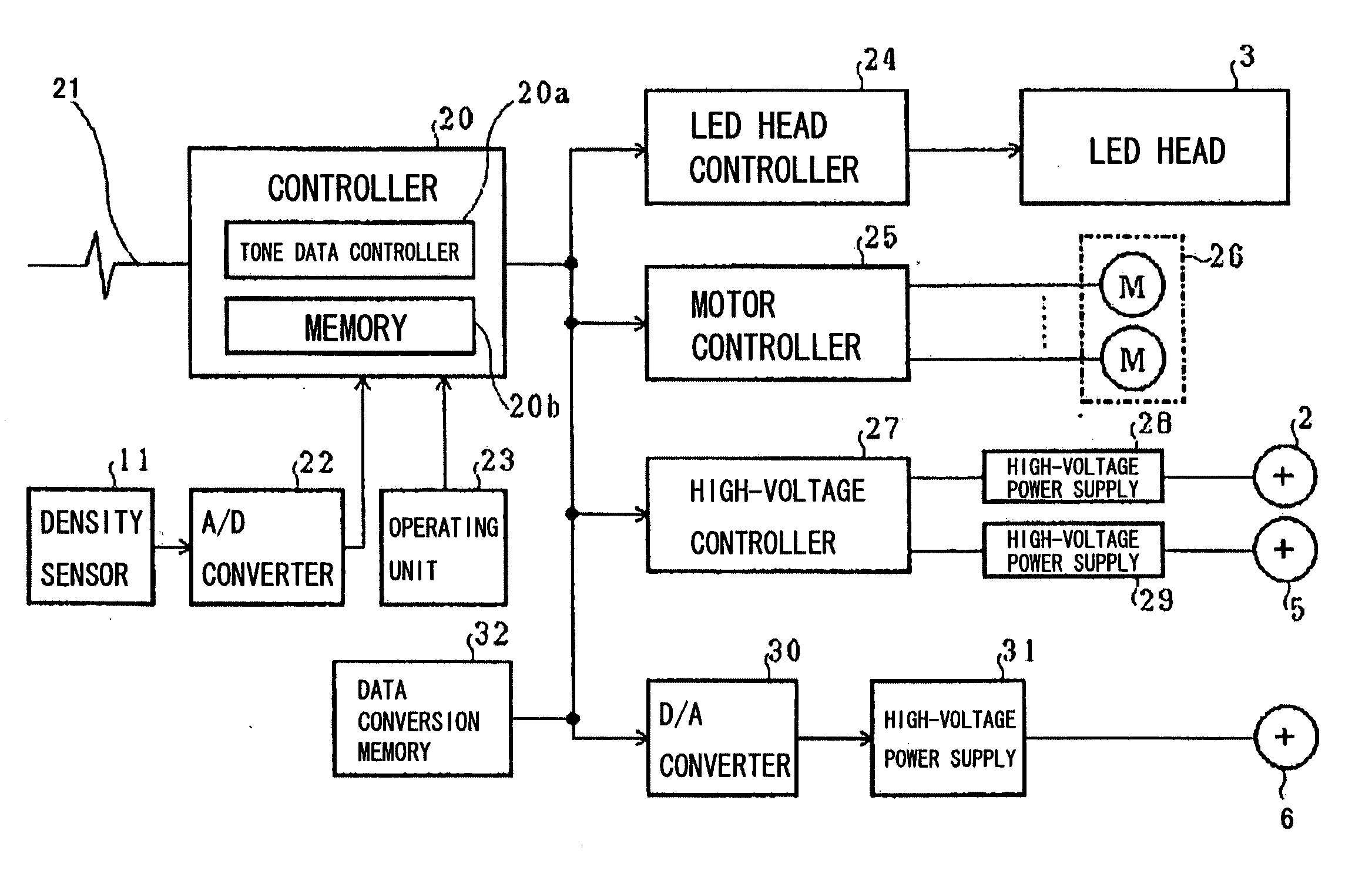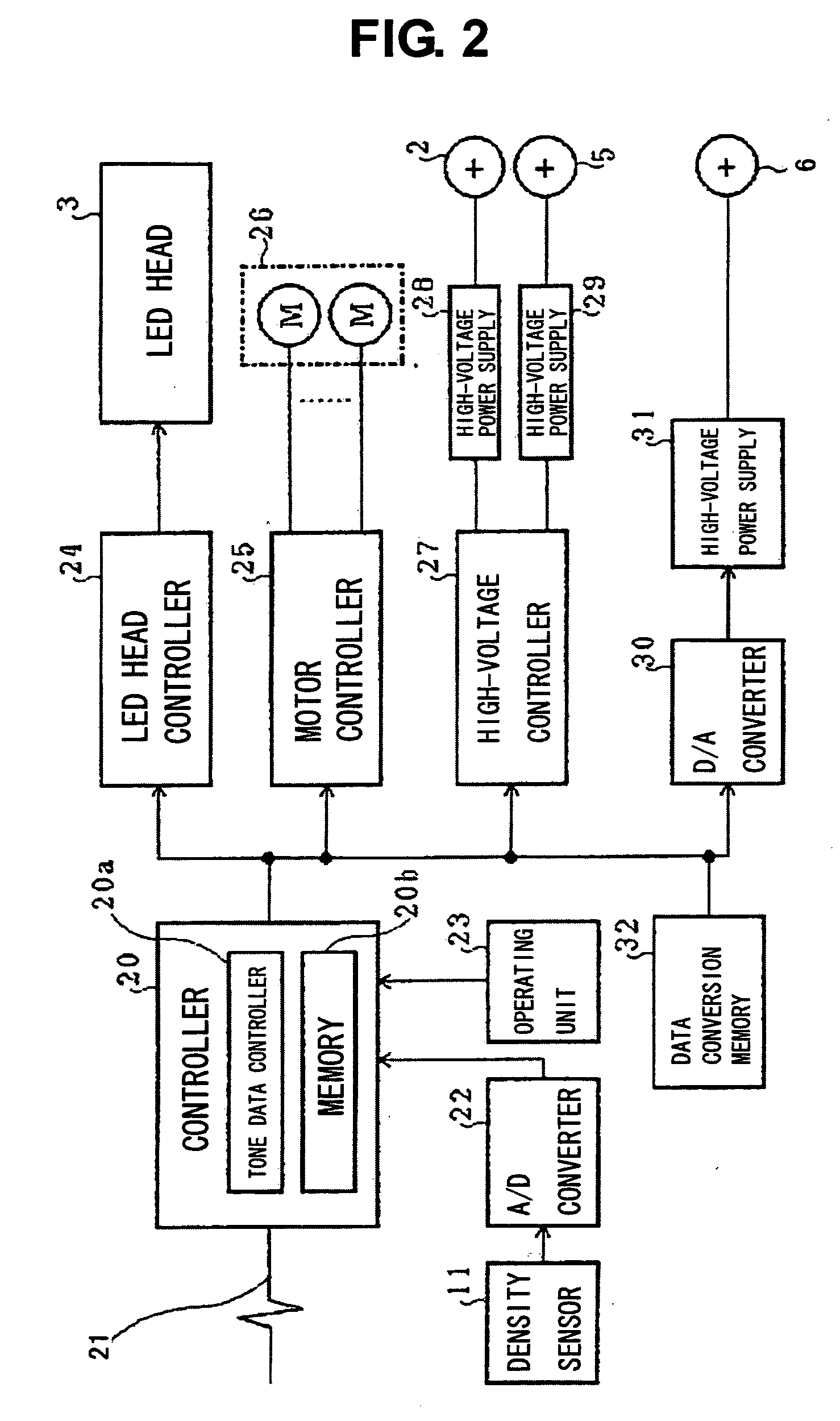Printing apparatus
a printing apparatus and printing technology, applied in the field of printing apparatus, can solve the problems that the linear tone reproduction curve cannot be solved in the conventional printing apparatus, and the linear tone reproduction curve cannot be solved in the conventional printing apparatus, and achieve the effect of excellent linear tone reproduction curv
- Summary
- Abstract
- Description
- Claims
- Application Information
AI Technical Summary
Benefits of technology
Problems solved by technology
Method used
Image
Examples
first embodiment
[0084] The printing apparatus is described first.
[0085] As shown in FIG. 1, the printing apparatus has a photosensitive drum 1 for forming an electrostatic latent image, a charging roller 2 to which high negative voltage is applied to charge a surface of the photosensitive drum 1 to predetermined negative voltage, and an LED head 3 in which the LED elements are arranged in an array form. The printing apparatus forms the electrostatic latent image on the charged photosensitive drum 1 upon selectively rendering the LED elements composing the LED head 3 emit the light. In the meanwhile, the LED head 3 is configured as a tone head capable of expressing density-tone according to input of data of multiple bits and can change an energy amount which is applied to every pixel.
[0086] The printing apparatus has a developing unit 4 for developing with toner the electrostatic latent image formed on the photosensitive drum 1. The developing drum 4 charges and supplies the toner to the developin...
second embodiment
[0131] The printing apparatus is described next.
[0132] With the printing apparatus according to the second embodiment, a tone value per pixel is modulated based on a luminous intensity, not on the emission time of each LED element likewise the first embodiment. In the second embodiment, the elements substantially the same as those in the first embodiment are assigned with the same reference numbers so that those duplicated description are omitted.
[0133] The printing apparatus according to the second embodiment realizes such a function as shown in FIG. 24 in using the controller 20 and the LED head controller 24.
[0134] To be more specific, the printing apparatus has a strobe intensity control circuit 61 in addition to the image data line buffer 51, the driving pattern converter 52, and the line synchronization signal generating circuit 54.
[0135] Every time the m-line synchronization signal generated by the line synchronization signal generating circuit 54 arrives, the strobe inte...
third embodiment
[0140] The printing apparatus is described next.
[0141] The printing apparatus according to the third embodiment has measures against the printing operation in binary mode, in addition to having the same tone expression capacity as that in the first embodiment. Therefore, in the third embodiment, the elements substantially the same as those in the first embodiment are assigned with the same reference numbers so that those duplicated description are omitted.
[0142] The printing apparatus according to the third embodiment realizes such the function as previously shown in FIG. 3 in using the controller 20 and the LED head controller 24. Herein, the image data transmitted from the host apparatus in a case of printing in the binary mode are composed of 5 bits per pixel but only the least significant bit PLX [0] or the most significant bit PIX [31] is transmitted and the other values are not transmitted.
[0143] In the printing apparatus as described above, on the condition that the image ...
PUM
 Login to View More
Login to View More Abstract
Description
Claims
Application Information
 Login to View More
Login to View More - R&D
- Intellectual Property
- Life Sciences
- Materials
- Tech Scout
- Unparalleled Data Quality
- Higher Quality Content
- 60% Fewer Hallucinations
Browse by: Latest US Patents, China's latest patents, Technical Efficacy Thesaurus, Application Domain, Technology Topic, Popular Technical Reports.
© 2025 PatSnap. All rights reserved.Legal|Privacy policy|Modern Slavery Act Transparency Statement|Sitemap|About US| Contact US: help@patsnap.com



